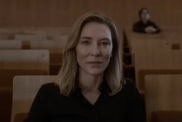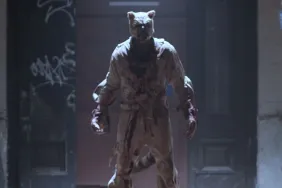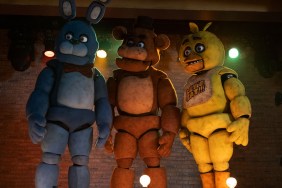
Now, filmmakers with years of experience in horror are using Kickstarter in an effort to fund a new sci-fi/horror feature. You may not know their names, but you definitely know their work. Alec Gillis and Tom Woodruff, Jr. operate Amalgamated Dynamics, Inc. They have created practical animatronic and makeup effects for Tremors, Wolf, Starship Troopers, Alien 3, Alien: Resurrection, Alien vs. Predator, and The Thing remake.
Gillis will write and direct and Woodruff, Jr. will produce Harbinger Down, described as a tense, claustrophobic full-length creature film that will feature only practical animatronic and makeup effects. It concerns a group of grad students studying global warming in the Bering Sea. After discovering old Soviet space wreckage, they are confronted with mutated creatures resulting from Soviet experiments with tiny animals that are able to withstand space radiation.
Gillis spoke with Shock Till You Drop about Kickstarter, practical effects, the current state of horror, and more.
Shock Till You Drop: The pitch video mentions the frustration you guys experienced with The Thing remake, and how in the end the movie’s effects are almost entirely CGI. Was that the final straw? Did that experience directly lead to the decision to make Harbinger Down?

Related Links: Check out those vids HERE, HERE and HERE.
I wouldn’t call our experience on The Thing a last straw, but I would call the fan response a first step. We’re just following their lead.
Shock: A lot of low-budget horror movies are given a theatrical release every year, many by a major studio (Paranormal Activity series, Sinister, The Purge). Why then is it hard to get backing for a project like this? What does that say about the current state of the genre?
Gillis: Which genre films get to the screen has to do with the studios second-guessing the market. If you’re outside the perceived safe zone of what they think is popular, it’s a hard sell. When the rage was supernatural horror, studios only wanted ghost children with hair hanging in their faces. Recently a Sales Agent asked if there could be a vampire or zombie in this movie to make it easier to sell. I refused. Nothing wrong with zombies and vampires, they just aren’t in this movie. We’re hoping that fans will be excited enough by what we’re offering so that we can circumvent short-sighted studio thinking.
Shock: With the Veronica Mars and Zach Braff projects, Kickstarter has been a hotly debated topic recently. You guys have worked with on large projects for big studios, and some have opined that cash-strapped filmmakers can’t compete with people who have existing Hollywood connections. What’s your take on that?
Gillis: I have mixed feelings. On one hand Mr. Braff and Veronica got funded, so the people have spoken. On the other hand, did those filmmakers divert fan money from other worthy projects when they could have gotten the funds through more traditional means? I don’t know the answer. I think we’re in a different category than them. Despite our credits, we are not personally wealthy. Harbinger Down’s budget is just enough to pay for the nuts and bolts of the film. Tom and I expect to pay for the creature FX ourselves through sweat equity, our studio’s assets, and plain old free work. The kinds of budgets Veronica Mars and Mr. Braff got will enable them to all get paid. Not so with us. It’s a labor of love. The biggest difference is that we are answering a call. Fans of Practical creature FX have been begging for someone to step up and represent them. I think we’re the right guys to fill that role.

Gillis: It’s a tired phrase, but it all starts with story. The best directors I’ve worked with are the ones who really bang at the pillars of the script to make sure it’s sound. Some directors who start in FX think that the story is just the filler between FX sequences. The truth is that if the story is solid and you care about the characters, the FX will work better. I have the chops in the creature realm, I have the crew and the process for that. You can be damn sure I’m not going to drop the ball in directing and writing because that’s the foundation of it all. Luckily, I’ve been writing for the last 15 years or so, and have sold some stuff and optioned stuff. I’m not a newbie there, just not as well known in those arenas.
Shock: You’ve said that this is a small film and there will be no digitally animated creatures in it. When I hear “aggressively mutating organisms,” that sounds awfully complicated and difficult to accomplish without digital animation. How do you pull that off on a small budget?
Gillis: I admire the sci-fi/horror films of the ’80’s not just as examples of practical creature FX and story structure, but in terms of editing too. The advent of CGI has moved us away from tension building editing like the kind we saw in Alien and Aliens. Digital FX tend to distance us from the action when they show too much unfold before our eyes. The fear is as much what we don’t see and what we see. A favorite moment of mine is when the facehugger leaps from the egg in Alien. Even frame by frame it’s hard to tell what’s happening, but the cumulative effect of the shots is highly impactful. Keep in mind that the goal is to put the practical creatures first. We’ll use digital techniques of rod/rig removal and compositing to make the animatronics and makeup more effective, but there will be no digital creature FX in the film! By the way, top of the line CGI is 3 to 6 times more expensive than top of the line animatronics. Real is cheaper. That’s a win-win for the audience.
To learn more about the project and watch a pitch video, visit THIS SPOT.
Stay up to date with the latest horror news by “liking” Shock Till You Drop’s Facebook page and following us on Twitter!









